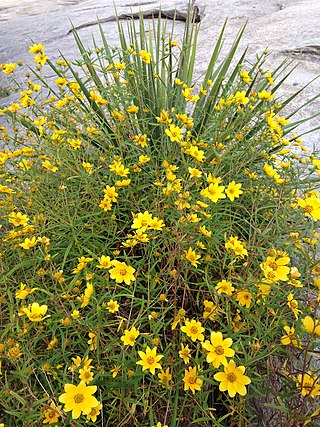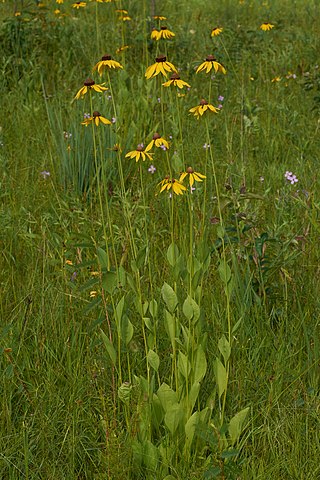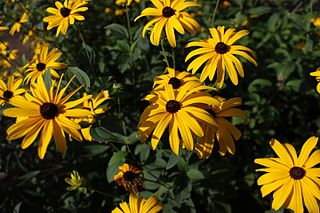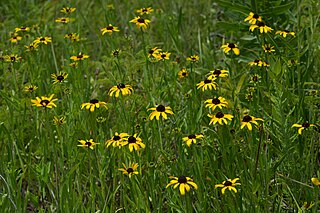
Beneficial insects are any of a number of species of insects that perform valued services like pollination and pest control. The concept of beneficial is subjective and only arises in light of desired outcomes from a human perspective. In agriculture, where the goal is to raise selected crops, insects that hinder the production process are classified as pests, while insects that assist production are considered beneficial. In horticulture and gardening, beneficial insects are often considered those that contribute to pest control and native habitat integration.

Rudbeckia hirta, commonly called black-eyed Susan, is a North American flowering plant in the family Asteraceae, native to Eastern and Central North America and naturalized in the Western part of the continent as well as in China. It has now been found in all 10 Canadian Provinces and all 48 of the states in the contiguous United States.

Rudbeckia is a plant genus in the Asteraceae or composite family. Rudbeckia flowers feature a prominent, raised central disc in black, brown shades of green, and in-between tones, giving rise to their familiar common names of coneflowers and black-eyed-susans. All are native to North America, and many species are cultivated in gardens for their showy yellow or gold flower heads that bloom in mid to late summer.

Rudbeckia laciniata, the cutleaf coneflower, is a species of flowering plant in the family Asteraceae. It is native to North America, where it is widespread in both Canada and the United States. Its natural habitat is wet sites in flood plains, along stream banks, and in moist forests. Common names other than cutleaf coneflower include cutleaf, goldenglow, green-headed coneflower, tall coneflower, sochan and thimbleweed.

Rudbeckia fulgida, the orange coneflower or perennial coneflower, is a species of flowering plant in the family Asteraceae, native to eastern North America.
Rudbeckia alpicola, the showy coneflower, Washington coneflower, or Wenatchee mountain coneflower. It is a perennial flowering plant native to Washington state in the United States.

Rudbeckia triloba, the browneyed or brown-eyed susan, thin-leaved coneflower or three-leaved coneflower, is a species of flowering plant in the family Asteraceae with numerous, yellow, daisy-like flowers. It is native to the central and eastern United States and is often seen in old fields or along roads. It is also cultivated as an ornamental.

Glyceria maxima, imfe Nd commonly known as great manna grass, reed mannagrass, reed sweet-grass, and greater sweet-grass is a species of rhizomatous perennial grasses in the mannagrass genus native to Europe and Western Siberia and growing in wet areas such as riverbanks and ponds. It is highly competitive and invasive and is often considered to be a noxious weed outside its native range.

Rudbeckia californica is a species of flowering plant in the family Asteraceae, known by the common name California coneflower.

Rudbeckia occidentalis is a species of flowering plant in the family Asteraceae known by the common name western coneflower. It is native to the northwestern United States from Washington to northern California and east to Wyoming and Montana, where it grows in moist habitat types, such as meadows. It is an erect perennial herb growing from a thick rhizome, its mostly unbranched stem approaching two meters in maximum height. The large leaves are generally oval but pointed, and lightly to deeply toothed along the edges, growing to 30 centimeters long. The inflorescence is one or more flower heads with purplish bases up to 6 centimeters wide. There are no ray florets, just an array of reflexed phyllaries around the purple-brown center packed with disc florets. This center, containing the receptacles, lengthens to several centimeters in length as the fruits develop. The fruits are achenes each a few millimeters long, some tipped with pappi of tiny scales.

Sagina maxima is a species of flowering plant in the family Caryophyllaceae known by the common names stickystem pearlwort and thick-stemmed pearlwort. It is native to the west coast of North America from Alaska to California, where it can be found in many types of sandy and rocky coastal habitat. It is a small, fleshy perennial herb growing in a clump of linear leaves and thick stems. The fleshy, pointed leaves are 1 or 2 centimeters long. The inflorescence is a solitary flower with five sepals and five small white petals. There are two subspecies which differ mainly in the arrangement of hairs on the stem.

Astrantia maxima,, is a species of flowering plant in the family Apiaceae.

Helianthus porteri is a species of sunflower known by the common names Porter's sunflower, Stone Mountain daisy and Confederate daisy. The term "daisy" is imprecise because the species is a sunflower (Helianthus) rather than a daisy. Likewise, although the plant grows on Stone Mountain, GA, its range extends well beyond. The connection to the Confederacy is through Stone Mountain which contains a confederate monument, although the connection is tenuous as the species was named before the Civil War in 1849 by Harvard botanist Asa Gray in honor of Thomas Conrad Porter, a Pennsylvanian minister and botanist who collected the plant in Georgia. Gray initially named the plant Rudbeckia porteri, later changed to Helianthus in 1998 by John F. Pruski.
Isophrictis rudbeckiella is a moth of the family Gelechiidae. It was described by Bottimer in 1926. It is found in North America, where it has been recorded from Alabama, Iowa, Kansas, Louisiana, Mississippi, Ohio and Texas.

Rudbeckia grandiflora, commonly called rough coneflower, is a species of flowering plant in the family Asteraceae.

Rudbeckia subtomentosa, the sweet coneflower, is a flowering plant in the family Asteraceae and is found in the central United States.

Rudbeckia missouriensis, the Missouri coneflower, is a flowering plant in the family Asteraceae and is found mostly in the Ozarks of Missouri and Arkansas in the central United States.
Rudbeckia graminifolia, the grassleaf coneflower, is a species of flowering plant. It grows in parts of the Florida Panhandle. It produces tubular disc flowers, which go on to form seeds and ray flowers. The flowering plants have been spotted in wet roadside ditches.
















